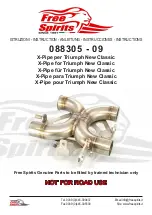
4
K
K
Back Filling
Pre-assemble the hopper and bend before connecting to the inlet connection and the pipe from the outlet
connection.
Using the same GEN 3 concrete with little moisture as the bed, back fill the sides level with the top of the trap
body. Ensure the hopper/bend assembly is securely held in the correct position during back filling.
Allow moisture from the ground to be absorbed by the concrete and time for it to set.
Once set build a brick surround to the approximate height of the square hopper and fit the cover and frame to
be level with the square hopper (path level).
NOTE:
The brick surround should not protrude over the inner edge of the body, which may prevent removal of
the tray when full of grease.
Backfill the remaining hole with concrete and the finally surface for the pathway ensuring the frame is securely
located and sealed along its outer edges.
A grate or sealing plate should be fitted to the square hopper.
Gully Plug and Tray
Ensure the gully plug is located in the discharge hole inside the body and is pressed firmly in place. This must
remain in place at all times to ensure correct functioning of the grease trap.
Finally fit the perforated tray and refit the cover.
Periodic Inspection
The lid should be lifted at weekly intervals to check the level of fats, oils and greases (FOG) in the tray. During
periods of heavy rain the grease trap should be inspected daily to ensure that the water is discharging
satisfactorily and FOG contents are not evacuated upwards past the lid.
Cleaning Instructions
Cleaning operations should only be carried out with the trap cold. The operator should wear eye protection and
protective gloves.
• The frequency of cleaning will vary depending on a wide variety of factors.
Washing of utensils and dishes will accumulate less grease than one in a full service restaurant with food
preparation. Another factor affecting the cleaning cycle is whether a waste disposal unit is discharged into
the grease trap and whether the food speciality is high in FOG.
• Frequent cleaning will minimise the build up of bacteria and objectionable odours.
• Prepare a suitable container into which the greases can be deposited.
• Lift the lid and clean the rim and underside and put aside.
• Use a sieve to skim out accumulated grease and deposit in the container
• Raise the perforated tray and allow residual water to drain back into the trap.
• Transfer the retained grease into the container.
• Clean out the tray and wash with hot water and household detergent.
• Remove excess greases from inside the trap body and place in the container.
• Re-install the perforated tray and re-fit the lid.
Ensure that grease removed from the grease trap is disposed of responsibly. Check with the local Council Waste
Disposal Department regarding the permitted method and location for safe disposal.
Warning:
the weight of a full tray of grease can exceed 25 kgs and the elevation within the trap makes
removal difficult.
Extreme care is needed when lifting a full tray of grease.
























